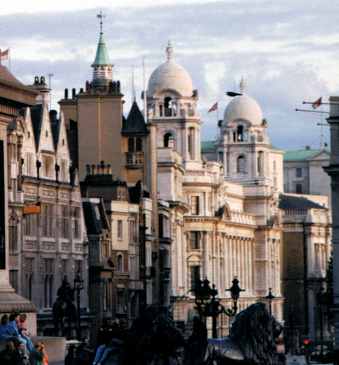A Travel Itinerary for Europe Will
Bring Your Trip to Life
When you create a travel itinerary for Europe you breathe life into your trip.
This is when you get up close and personal with where you want to go in Europe, the experiences you want to have, and the things you want to do.
Your travel itinerary for Europe is the outline around which you create your plan for traveling.
It's the cornerstone for construc-ting your trip; the blueprint for your dreams and memories.
To create a Europe itinerary, start with the amount of time you’ve determined for the length of your trip.
If you have only a week or so for travel, Europe should not be on your short list as a destination.
Sure, you can fly into Paris for a long weekend or spend a whirlwind week in the UK. But you won’t have time to do more than hit the high spots.
Your body will be out of sync for most of the time you're there. And once you're home, you'll barely remember what you went so far to see.

Traveling in Europe is an intense physical and emotional experience.
To cover just a small part, your travel itinerary should be a minimum of two weeks.
The average visit of 18-21 days is even better.
This number of travel days gives you time to absorb your flight days into your travel time without seriously impacting your time on the ground.
It gives your body time to adjust to the impact of of a strange new culture.
Flying days are obviously necessary days. But they are also wasted days as part of your overall travel plan.
By having a longer travel period, these days - wiled away in airports, airplanes, and security lines - become an important period of transition for both body and mind.
And, you'll still have time for intensive 'on the ground' travel.
A trip of 2 - 3 weeks gives your body time to adjust to the changes that occur when you travel multiple time zones away from home.
Daylight hours, sleeping patterns, the food you eat, can each affect you for several days, as your trip begins.
Depending on how far away your destination is from home, it can take up to a week for your body to fully adjust.
Most studies show it takes one day for each time zone you cross to reset the circadian rhythm of your internal body clock.
During this period, neither your physical stamina or your mental abilities are at their peak.
Why Do a Travel Itinerary?
Creating a Europe travel itinerary gives you the opportunity to solidify your ideas of where to go and what to do while traveling in Europe.
It allows you to build flexibility into your trip, so you can be sure to see all the things you want to see.
It's not uncommon, especially for those new to international travel, to over schedule things to do and places to visit, not allowing enough time for getting to and from.
The most common result of over scheduling is having to skip parts of your travel plan, or choose one destination at the expense of another, just because there's not enough time to do it all.
By building in flexibility, it's possible to adjust your schedule en route, so you can do everything you want to do - or change your plans for something new.
Building a Europe itinerary gives you the ability to personalize your plans and travel goals.
It allows you to match your style of travel to your time and budget.
If you've done your research, you already have a general idea about the geography of your destination - a feel for where you want to travel locally.
You know how close - or far - the places you want to visit are from each other and the time needed for 'on the ground' travel between them.
You've decided which cities, towns, and villages you want to visit and what each has to offer.
You've organized your options with the materials and information you've gathered, so you can prioritize the most important things to see and do.
You have a mental list of what to include in your Europe travel plan, and how to shape your daily schedules to accommodate them.
Now it's time to put pen to paper [or fingers to keyboard] and lay out your trip. It's time to create your European itinerary.
Create a European Itinerary Like A Pro
The 2nd biggest mistake most travelers make when creating a travel itinerary is scheduling too tightly. [We'll discuss the 1st biggest mistake in a moment!]
Even though distances in Europe are relatively short, there are other things that can impact your pre-arranged travel plans.
Driving in unfamiliar areas, laws and rules of the road, local traffic congestion - each can wreck havoc on your timetable for travel.

Check any brochure for escorted group tours, and you'll find 'free time' is always built into the schedule.
Free time creates the flexibility factor.
It's time you can use to eat a meal in that cute little bistro you saw; re-visit a museum for a second glance [or see one that was closed]; make up for bad weather, traffic, or long entrance lines. Or just to relax and people watch.
It’s the most important time to include in your travel itinerary.
As mentioned in this article, major European cities require a minimum of 3 or 4 days and nights, just to see the main sights and attractions.
Smaller cities or towns need less, but no less than 2 nights in each.
Eating, sleeping, local travel time, figuring out where you are and where you're going, all play into your travel 'stops'. A two-night stay gives you only one day to see and experience your surroundings.
If you don't feel there's enough to do in a particular area to merit a 2-night stay [one full day of sightseeing], skip it for a more interesting venue.
Build your travel itinerary like a hub and spoke.
Plan to radiate out from your 'base hotel' for daily activities and nearby sights and attractions that aren't directly on your travel route. This will eliminate the hassle of having to move into and out of a different hotel each night.
You'll remove much of your travel stress by staying a minimum of 2-4 nights in the same hotel. You'll discover a sense of familiarity - even comfort - when you reduce your 'on the road' time from every day, to every several days.
Once you've positioned several of your overnight stops into your travel itinerary, mark them on a map.
This makes it easier to visualize your stops in relation to each other and develop a travel route based on these hub locations.
Maximize Your Itinerary and Minimize Wasted Time
Creating a Europe travel itinerary is an ongoing work in progress. It takes patience and a good eraser to make it work.
The goal for your European itinerary is to maximize your exposure to the sights, sounds, smells, and sensations that drew you to your travel destination.

Building your travel itinerary is about picking and choos-ing the things most important to see and do on your European trip.
Doing quality research, both on-line and off-line, will help you de-velop a workable travel route and guide you to the stops you'll make along the way.
A workable travel itinerary should help you decide which locations are worthy for inclusion in your travel plan and which are out of the way or not significant relative to their distance and location.
By doing the necessary work to create a comprehensive travel itinerary, it can prevent you from over-scheduling what you can realistically do in your allotted travel time.
Not creating a travel itinerary is the biggest mistake you can make when planning your trip to Europe.
But if you design your itinerary with knowledge, thought, and flexibility, your Europe itinerary will become your most important planning tool and insure the success of your trip.
For more tips on planning a European trip, try the following pages:
Planning a Trip to Europe? Include the most important thing to
insure your trip’s success.
Use your Travel Budget to keep your travel costs under control.
Does your Europe Travel Plan include everything you want to
see and do in Europe?
Budgeting For Travel lets you know your money will last as long
as your trip.
How your Travel Attitude will increase the benefits of traveling.
Return to Getting Travel Ready
Travel Tip
Try not to schedule heavy sightseeing on the day you arrive on your overseas flight. Use that day to settle in, get your bearings, rest, and allow your body clock time to re-adjust.
The same thing applies when you return home. Allow at least one full day to unpack and re-group, before heading back to your normal routine. Adjusting to different time zones works both going and coming!
Return to Homepage | Return to Top....
Updated Travel Topics
Make Your Packing Easier and your Trip More Organized...

Packing Cubes from eBags

Our Readers Say...
Thanks for providing all these awesome resources for travel addicts on your website! ~ Sally D./Canada
I enjoyed looking through your website, especially the article you've written about yourself and your passion for travel. I share the same passion. ~ Theresa C./US
This is the first time I’ve visited your site, and it's fantastic. I think it's a terrific resource as an all-travel portal. ~ Steven F./US
I’ve been reading your blog, travel-safe-travel-smart.com and found the article 'Use The Best Travel Guides To Plan Your Trip' extremely interesting. ~ Jessica B./US













